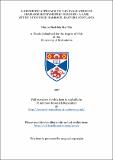A heuristic approach to the evaluation of seafloor bathymetric changes : a case study of Dundee Harbour, Eastern Scotland
Abstract
The phenomena of seabed bathymetric changes in Dundee harbour, eastern Scotland have been investigated, by use of archive bathymetric data. The bathymetric data were available from the Dundee Port Authority, from its past annual harbour maintenance programmes during the period of 1989 to 1993. Archive bathymetric data are seen as under-utilised, after being used for their intended purposes. A methodology was therefore developed to use sequential bathymetric data to estimate the deposition and erosion of sediment over a period of time. This is in the form of a systematic procedure of processing for comparison of data from different dates. The comparison or differencing of bathymetric data in their original form cannot be directly applied. This would require each data point to be located at spatially common positions (i.e. grid points) and could be achieved only through interpolation. A procedure known as 'gridding' is instead used to prepare depths at the spatially fixed points or nodes. Six different methods of interpolation have been examined and trial computations using a common data subset for each individual method conducted. The results of the interpolation were often substantially different from one method to another. A technique known as the Blending Interpolation Technique is proposed to overcome the uncertainty in depth interpolation. Computer programs were specifically written for this study and for the visualisation of the phenomena of deposition and erosion, use was made of the available UNIRAS software package. The methodology and procedures of this study are not only applicable for an estuarine harbour environment, but are also equally applicable to any areas such as large reservoirs, lakes or coastal ports and harbours, that are continuously affected by the phenomena of sedimentation and erosion, where their estimation and quantification are of critical importance. This study, however, has demonstrated the usefulness of the Blending Interpolation Technique which is seen as a future tool to detect, monitor and quantify seabed changes, in particular where bathymetric data of the same area are available from different dates. It also serves to prolong the usefulness of archive bathymetric data kept for an area.
Type
Thesis, PhD Doctor of Philosophy
Collections
Items in the St Andrews Research Repository are protected by copyright, with all rights reserved, unless otherwise indicated.

